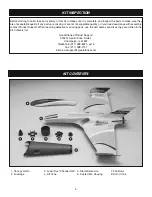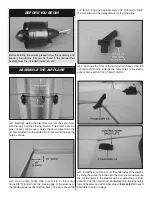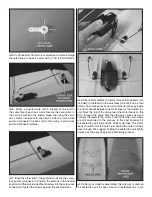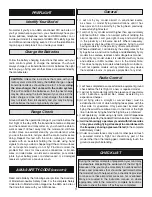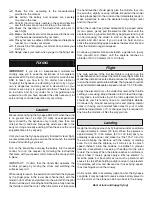
10
NOTE:
The throws are measured at the
widest part
of the
elevons (not including the fl ared inside tips of the elevons).
These are the recommended control surface throws:
High Rate
Low Rate
ELEVATOR:
1/4" [6mm] up
3/16" [4.8mm] up
1/4" [6mm] down
3/16" [4.8mm] down
AILERONS:
3/8" [9.5mm] up
1/4" [6mm] up
3/8" [9.5mm] down 1/4" [6mm] down
IMPORTANT:
The Synapse ARF has been
extensively
fl own
and tested to arrive at the throws at which it fl ies best. Flying
your model at these throws will provide you with the greatest
chance for successful fi rst fl ights. If, after you have become
accustomed to the way the Synapse fl ies, you would like to
change the throws to suit your taste, that is fi ne. However, too
much control throw could make the model diffi cult to control,
so remember, “more is not always better.”
Note:
When setting the neutral points of the elevons, place a
straight edge on the underside of the wings from the carbon
tube back to the elevons. For your fi rst few fl ights, position the
neutral points of the elevons level with the wings as shown.
Balance the Model (C.G.)
More than any other factor, the
C.G.
(balance point)
can have the
greatest
effect on how a model fl ies, and
may determine whether or not your fi rst fl ight will be
successful. If you value this model and wish to enjoy it for
many fl ights,
DO NOT OVERLOOK THIS IMPORTANT
PROCEDURE.
A model that is not properly balanced will
be unstable and possibly unfl yable.
At this stage the model should be in ready-to-fl y condition
with all of the systems in place including the receiver, ESC,
and battery pack.
❏
1. Use a felt-tip pen or 1/8" [3mm]-wide tape to accurately
mark the C.G. on the top of the wing on both sides of the
fuselage.
The C.G. is located 1-15/16" [49mm] back from
the leading edge of the wing at the fuselage (the seam
where the wing panels have been joined to the fuselage).
This is where your model should balance for the fi rst fl ights.
Later, you may wish to experiment by shifting the C.G. up to
1/8" [3mm] forward or 1/8" [3mm] back to change the fl ying
characteristics. Moving the C.G. forward may improve the
smoothness and stability, but the model may be more diffi cult
to slow for landing. Moving the C.G. aft makes the model
more maneuverable, but could also cause it to become too
diffi cult to control. In any case, start at the recommended
balance point and do not at any time balance the model
outside the specifi ed range.
❏
2. With all parts of the model installed (ready to fl y), place
the model upside-down on a Great Planes CG Machine, or
lift it upside down at the balance point you marked.
❏
3. If the tail drops, the model is “tail heavy” and the battery
pack and/or receiver must be shifted to balance. If the nose
drops, the model is “nose heavy” and the battery pack and/or
receiver must be shifted to balance. This model is very weight
sensitive. Do not add any weight to achieve the suggested
balance point. Instead, shift the battery pack and receiver
forward or aft to alter the C.G.





